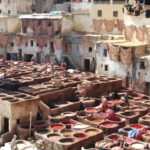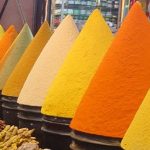Discover the culinary wonders of Morocco through its tantalizing tajines—slow-cooked stews that combine tender meat, aromatic vegetables, and flavorful sauces. These exquisite dishes are traditionally prepared in a special pot called a tajine, featuring a unique knob-shaped cover that allows for easy removal. With the cover lifted off, the cook can inspect and enhance the dish by adding vegetables, rearranging ingredients, or adding more braising liquid. For an unforgettable experience, immerse yourself in the art of making a tajine through a firsthand adventure like A Taste of Morocco Food Tour.
In Morocco, the term “tajine” refers not only to the dish itself but also to the distinctive pot used for cooking. Crafted from heavy clay, the traditional tajine pot may be beautifully painted or glazed. It consists of two parts—a flat, circular base with low sides and a large cone or dome-shaped cover that sits snugly inside the base during cooking. The cover is designed to promote condensation, ensuring that all the flavorful juices return to the bottom. When it’s time to serve, the cover can be removed, and the base can be brought directly to the table.
Table of Contents
Moroccan tajines typically feature slow simmering of more affordable cuts of meat. Lamb neck, shoulder, or shank are ideal choices, cooked until they become incredibly tender and effortlessly fall off the bone. Unlike other cuisines, browning the meat is usually done after simmering, resulting in moist, buttery texture. To achieve this, the cooking liquid must contain some fat, which can be skimmed off later.
The beauty of Moroccan tajines lies in the combination of meat—such as lamb or chicken—and a variety of ingredients and seasonings. From olives, quinces, and apples to pears, apricots, and raisins, a tajine offers a harmonious blend of flavors. The addition of preserved lemons, honey, and an array of spices like cinnamon, saffron, ginger, turmeric, cumin, paprika, pepper, and Ras el hanout creates a complex and aromatic profile. Some well-known tajine variations include mqualli or emshmel (pairing chicken, olives, and citrus fruits with unique preparation methods), kefta (meatballs in an egg and tomato sauce), and mrouzia (lamb with raisins and almonds).
Tajines can also incorporate a diverse range of ingredients that braise well, such as fish, quail, pigeon, beef, root vegetables, legumes, and even exotic elements like amber and aga wood. In the Western world, modern adaptations include dishes like pot roasts, ossobuco, lamb shanks, and turkey legs. The choice of seasonings can draw inspiration from traditional Moroccan spices, as well as French, Italian, or other flavors that complement the dish.
In an effort to keep up with modern cooking methods, Morocco has started embracing the efficient pressure cooker for making tajines. European manufacturers have also introduced tajine pots with heavy cast iron bottoms, enabling high-heat stovetop searing of meats and vegetables before cooking. While Dutch ovens and cast iron pots excel at braising in the oven, tajine pots are best suited for stovetop cooking.
For those who prefer to stay true to the traditional cooking methods while saving time, saucepans and casseroles can still be used over a gas flame instead of a slow fire. Whether you choose the authentic tajine pot or a suitable alternative, the key to preparing a delicious tajine lies in cooking with love and care. It’s important to note that tajines are best suited
for smaller groups or intimate gatherings, as they tend to have a higher proportion of sauce compared to solid ingredients. This allows for a more flavorful and enjoyable dining experience with your family or close friends.
Tajines are a true delight for food enthusiasts who appreciate the exotic flavors of marinated lamb or chicken in olive oil and garlic. For vegetarians, it’s possible to request a meat-free version of the tajine during your travels in Morocco. The meats are first sautéed to enhance their flavors and then enriched with a combination of marinades, including saffron, cumin, crushed red pepper, fresh coriander, parsley, chickpeas, and almonds. Moroccans often add playful elements to the dish, such as prunes, ginger, or hard-boiled eggs. An essential component of any classic tajine is the inclusion of chicken, olives, and salted lemons.
To recreate the authentic taste of Moroccan home cooking, there are a few tips and tricks worth noting. Start by using cooking butter or, if preferred, olive oil, and generously incorporate finely chopped onions. Sauté the onions until they reach a soft and translucent state, as this will impart a creamy texture to the tajine sauce. Adding a touch of honey is another secret to enhance the overall flavors of the dish.
While specific spices, fats, and seasonal produce may vary across different regions of Morocco, one constant remains—the serving of tajine alongside couscous or freshly baked bread. These accompaniments serve as the perfect vessels for savoring the tender meat and flavorful vegetables, allowing you to fully immerse yourself in the rich Moroccan culinary experience.
Essential Ingredients for Authentic Tagine
A traditional tagine typically includes a combination of the following ingredients:
- Meat: Lamb, chicken, or beef (can be substituted with vegetarian options like tofu or chickpeas).
- Aromatic vegetables: Onions, garlic, carrots, bell peppers.
- Dried fruits: Apricots, raisins, dates, or prunes.
- Citrus flavors: Preserved lemons or fresh lemon juice.
- Olives: Green or black olives for a savory touch.
- Herbs and spices: Cumin, ginger, turmeric, paprika, cinnamon, saffron, coriander, and parsley.
- Nuts: Almonds, pine nuts, or slivered almonds for added texture.
- Liquid: Broth or water to create the sauce.
- Olive oil: Used for sautéing and flavoring.
- Optional sweeteners: Honey or brown sugar, depending on the desired taste.
These ingredients can be customized and varied based on personal preferences, regional traditions, or dietary restrictions. Experimenting with different combinations will allow you to create your own unique and flavorful tagine dishes.
In conclusion, Moroccan tajines offer a culinary journey filled with slow-cooked flavors, tantalizing aromas, and a fusion of ingredients that captivate the senses. Whether you embark on a food tour or try your hand at making them in your own kitchen, tajines are sure to transport you to the vibrant world of Moroccan cuisine, leaving an unforgettable impression on your taste buds.
Join countless satisfied travelers who have experienced Morocco with us. We customize every detail to make your Moroccan adventure uniquely yours. Explore the Magic of Morocco with us!

































































































































































































































































